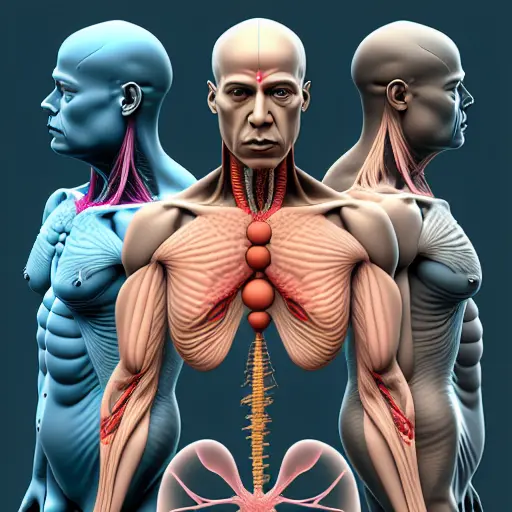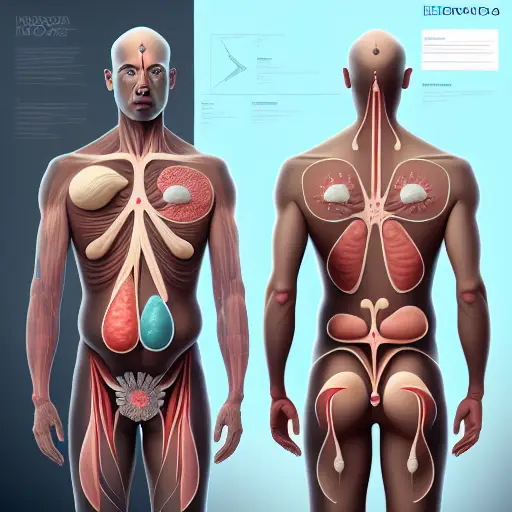What Is Multiple Endocrine Neoplasia Syndrome and Why It Happens

Multiple endocrine neoplasia syndrome is a rare genetic disorder that affects the endocrine glands. It occurs due to specific genetic mutations that disrupt normal cell growth, leading to tumor formation in glands like the thyroid, pancreas, and parathyroid. These mutations often involve genes such as MEN1, RET, and CDKN1B, which regulate cell division and growth.
Gene | Associated Type of MEN | Function Description |
|---|---|---|
MEN1 | Type 1 | Produces menin, a tumor suppressor that regulates cell growth and division. |
RET | Type 2 | Produces a protein involved in cell signaling, mutations lead to overactivation and unchecked growth. |
CDKN1B | Type 4 | Produces p27, a tumor suppressor that controls cell division; mutations reduce functional p27 levels. |
This syndrome is hereditary, meaning you can inherit it from a parent. Early detection is crucial because it allows for timely treatment and better management of symptoms. Globally, MEN type 1 affects about 1 in 30,000 people, while MEN type 2 occurs in 1 in 35,000 individuals.
Type of MEN | Prevalence Rate |
|---|---|
MEN type 1 | 1 in 30,000 |
MEN type 2 | 1 in 35,000 |
MEN type 2B | ~5% of type 2 |
MEN type 4 | Unknown |
If you suspect a family history of this condition, consulting a healthcare provider can help identify risks and guide preventive measures.
Key Takeaways
Multiple endocrine neoplasia syndrome is a genetic problem. It causes tumors in glands that make hormones.
Finding it early is very important. Talk to a doctor if your family has this condition. They can do tests and keep track of it.
Watch for signs like feeling tired, weight changes, or neck lumps. These can help you know when to see a doctor.
Treatment usually means surgery to take out tumors. Medicines can help control hormones and stop problems.
Regular doctor visits and healthy habits can make things better. They help you live well with this condition.
What Is Multiple Endocrine Neoplasia Syndrome?

Overview of MEN Syndrome
Multiple endocrine neoplasia syndrome is a rare condition that causes tumors to form in your endocrine glands. These glands produce hormones that regulate essential body functions like metabolism, growth, and stress response. The syndrome is classified into different types, each linked to specific genetic mutations. While some tumors are noncancerous, others can become cancerous if left untreated.
You might wonder why this condition is so significant. The endocrine system plays a critical role in maintaining your body's balance. When tumors disrupt hormone production, it can lead to serious health issues. Understanding this syndrome helps you recognize its impact and the importance of early detection.
How It Affects the Endocrine System
The endocrine system includes glands like the thyroid, pancreas, and adrenal glands. In multiple endocrine neoplasia syndrome, genetic mutations cause these glands to grow tumors. These tumors can either overproduce or underproduce hormones, leading to imbalances. For example, a tumor in the parathyroid gland might cause high calcium levels in your blood, which can weaken bones and affect kidney function.
You may experience symptoms like fatigue, weight changes, or even high blood pressure, depending on which gland is affected. The condition's effects vary, but they often disrupt your body's ability to function normally.
Why It Is Considered a Genetic Disorder
This syndrome is considered a genetic disorder because it results from mutations in specific genes. These mutations are often inherited from a parent, meaning you might be born with a higher risk of developing the condition. For instance, mutations in the MEN1 gene or RET gene are directly linked to the syndrome.
If you have a family history of multiple endocrine neoplasia syndrome, genetic testing can help identify your risk. Early diagnosis allows you to take preventive steps and manage the condition effectively.
Tip: If you suspect a family history of this syndrome, consult a healthcare provider for guidance on genetic testing and monitoring.
Types of Multiple Endocrine Neoplasia Syndrome
MEN Type 1 (MEN1)
MEN Type 1 primarily affects the parathyroid glands, pancreas, and pituitary gland. You might hear it referred to as Wermer’s syndrome. This type results from mutations in the MEN1 gene, which produces a protein called menin. Menin acts as a tumor suppressor, so when the gene mutates, tumors can form in these glands.
In MEN1, parathyroid tumors often cause hyperparathyroidism, leading to high calcium levels in your blood. This can result in symptoms like fatigue, muscle weakness, and kidney stones. Tumors in the pancreas may disrupt insulin production, causing blood sugar imbalances. Pituitary tumors might affect hormone levels, leading to issues like irregular menstrual cycles or vision problems.
MEN Type 2 (MEN2)
MEN Type 2 is linked to mutations in the RET gene. This type includes two subcategories: MEN2A and MEN2B. Both types often involve medullary thyroid cancer (MTC), but they differ in other associated conditions.
MEN2A
MEN2A accounts for about 95% of MEN2 cases. It typically involves MTC, pheochromocytoma (a tumor in the adrenal glands), and hyperparathyroidism. Symptoms of MTC may include a lump in your neck, hoarseness, or trouble swallowing. Pheochromocytoma can cause high blood pressure, headaches, and excessive sweating. Hyperparathyroidism might lead to joint pain, fatigue, or frequent urination.
MEN2B
MEN2B is rarer and more aggressive. It often presents with MTC and pheochromocytoma, but it also includes unique features like mucosal neuromas (benign growths on the tongue or lips) and a tall, slender body shape. Symptoms of MTC and pheochromocytoma in MEN2B are similar to those in MEN2A.
Rare Variants of MEN Syndrome
Rare variants of multiple endocrine neoplasia syndrome include MEN Type 4, which results from mutations in the CDKN1B gene. This type shares similarities with MEN1 but is much less common. Other rare forms may involve different genetic mutations and unique tumor patterns.
Note: If you notice symptoms like unexplained fatigue, neck lumps, or frequent urination, consult a healthcare provider. Early diagnosis can improve outcomes.
Causes of Multiple Endocrine Neoplasia Syndrome
Genetic Mutations and Their Impact
The primary cause of multiple endocrine neoplasia syndrome lies in genetic mutations. These mutations alter the normal function of specific genes responsible for regulating cell growth and division. For example, mutations in the MEN1 gene disrupt the production of menin, a protein that suppresses tumor growth. Without proper regulation, cells in your endocrine glands may grow uncontrollably, forming tumors.
Similarly, mutations in the RET gene lead to overactive cell signaling. This overactivity triggers abnormal cell growth, increasing the risk of tumors in glands like the thyroid or adrenal glands. These genetic changes not only cause tumor formation but also affect how your glands produce hormones, leading to imbalances that impact your overall health.
Inherited vs. Spontaneous Mutations
You might wonder how these mutations occur. In most cases, multiple endocrine neoplasia syndrome is inherited. If one of your parents carries a mutated gene, you have a 50% chance of inheriting it. This hereditary nature makes family history a critical factor in assessing your risk.
However, not all cases are inherited. Some mutations happen spontaneously during your lifetime. These spontaneous mutations occur without any family history and are often unpredictable. Regardless of how the mutation arises, the effects on your endocrine glands remain the same.
How Tumors Develop in MEN Syndrome
Tumors in multiple endocrine neoplasia syndrome develop when genetic mutations disrupt the normal cycle of cell growth and death. Healthy cells grow, divide, and eventually die in a controlled manner. Mutations in genes like MEN1 or RET interfere with this process, causing cells to grow uncontrollably.
Over time, these abnormal cells form tumors in your endocrine glands. Some tumors may remain benign, while others can become cancerous. The location of the tumor determines the symptoms you experience. For instance, a tumor in the parathyroid gland might lead to high calcium levels, while a tumor in the thyroid gland could cause a lump in your neck.
Tip: If you notice unusual symptoms like fatigue, weight changes, or neck lumps, consult a healthcare provider. Early detection can prevent complications.
Symptoms and Diagnosis of MEN Syndrome

Recognizing Common Symptoms
You may notice a variety of symptoms if you have multiple endocrine neoplasia syndrome. These symptoms often depend on the type of MEN syndrome and the glands affected. Common signs include:
Digestive issues like constipation, diarrhea, stomach pain, reflux, or nausea
Fatigue and muscle weakness
Increased thirst and frequent urination
Joint and bone pain
Kidney stones
Swelling in your hands and feet
These symptoms can vary widely. For example, someone with MEN1 might experience high calcium levels due to parathyroid tumors, leading to fatigue or kidney stones. In contrast, MEN2 may cause symptoms like high blood pressure or headaches from adrenal gland tumors. Recognizing these signs early can help you seek timely medical advice.
Tip: If you experience persistent symptoms like fatigue, digestive problems, or swelling, consult a healthcare provider for further evaluation.
Diagnostic Methods for MEN Syndrome
Diagnosing multiple endocrine neoplasia syndrome involves a combination of clinical evaluations, imaging tests, and laboratory studies. Your doctor may start by reviewing your medical history and conducting a physical exam. Blood tests can reveal hormone imbalances, such as elevated calcium or abnormal thyroid hormone levels. Imaging techniques like ultrasound, CT scans, or MRIs help identify tumors in your endocrine glands.
Doctors often use these methods to confirm the presence of tumors and assess their impact on your body. Early diagnosis through these techniques can prevent complications and improve treatment outcomes.
The Role of Genetic Testing in Diagnosis
Genetic testing plays a crucial role in diagnosing MEN syndrome. It identifies mutations in genes like MEN1, which are directly linked to the condition. Testing can detect these mutations even before symptoms appear, allowing for early intervention. It also helps uncover hormonal imbalances caused by MEN1 years before complications develop.
By undergoing genetic testing, you can gain valuable insights into your risk of developing MEN syndrome. This information enables you and your healthcare provider to create a personalized plan for monitoring and preventive care.
Note: If you have a family history of MEN syndrome, genetic testing can help you take proactive steps to protect your health.
Treatment and Management of MEN Syndrome
Medical and Surgical Treatment Options
Treating multiple endocrine neoplasia syndrome often involves a combination of medical and surgical approaches. The goal is to remove tumors, manage hormone imbalances, and prevent complications. Below is a table summarizing common treatments:
Treatment Type | Description |
|---|---|
Endocrine Surgery | Removes tumors and affected glands, such as thyroidectomy for thyroid glands. |
Medications | Includes hormone replacement therapy after gland removal and drugs to regulate hormone levels. |
Cancer Treatments | Uses chemotherapy and radiation therapy to shrink tumors and control cancer spread. |
Preventive Surgery | Removes the thyroid gland in high-risk patients before cancer develops. |
Surgery is often the first step, especially for tumors that pose immediate risks. After surgery, you may need medications to replace missing hormones or stabilize hormone levels. If cancer is present, treatments like chemotherapy or radiation may be necessary. Preventive surgery can also reduce the risk of cancer in individuals with a strong genetic predisposition.
Monitoring and Managing Symptoms Over Time
Managing this condition requires regular monitoring to track hormone levels and detect new tumors early. You may need periodic blood tests, imaging scans, and physical exams. These checkups help your doctor adjust your treatment plan as needed.
Lifestyle changes can also play a role in symptom management. Eating a balanced diet, staying hydrated, and maintaining a healthy weight can support your overall well-being. If you experience symptoms like fatigue or digestive issues, report them promptly to your healthcare provider. Early intervention can prevent complications and improve your quality of life.
Importance of Early Detection and Regular Checkups
Early detection is critical for managing multiple endocrine neoplasia syndrome effectively. Regular checkups allow your doctor to identify tumors or hormone imbalances before they cause severe symptoms. Genetic testing can also help you understand your risk and take preventive measures.
By staying proactive, you can reduce the impact of this condition on your life. Regular monitoring and timely treatment ensure better outcomes and help you maintain a healthier lifestyle.
Understanding multiple endocrine neoplasia syndrome helps you recognize its genetic basis, symptoms, and treatment options. Early diagnosis plays a vital role in managing this condition effectively. Regular checkups and genetic testing can help you detect potential risks and take preventive measures.
If you suspect a family history of this syndrome, consult a healthcare provider. Proactive management ensures better outcomes and improves your quality of life. Taking these steps empowers you to stay ahead of potential complications and maintain your health.
FAQ
What is the difference between MEN1 and MEN2?
MEN1 and MEN2 differ in the glands they affect and the genetic mutations involved. MEN1 primarily impacts the parathyroid, pancreas, and pituitary glands due to MEN1 gene mutations. MEN2, caused by RET gene mutations, often involves the thyroid and adrenal glands.
Can MEN syndrome skip generations?
No, MEN syndrome does not skip generations. If you inherit the mutated gene from a parent, you have a 50% chance of developing the condition. However, symptoms may vary among family members.
Is genetic testing necessary for MEN syndrome?
Yes, genetic testing helps confirm a diagnosis and assess your risk. It identifies mutations in genes like MEN1 or RET. Testing also allows early intervention, even before symptoms appear.
Are all tumors in MEN syndrome cancerous?
No, not all tumors are cancerous. Many remain benign, but some, like medullary thyroid cancer in MEN2, can become malignant. Early detection and treatment reduce the risk of complications.
How can you manage MEN syndrome long-term?
Regular checkups, blood tests, and imaging scans help monitor your condition. Surgery or medications may manage symptoms. A healthy lifestyle, including a balanced diet and exercise, supports overall well-being.
Tip: Stay proactive with regular screenings to detect changes early and improve outcomes.
---
ℹ️ Explore more: Read our Comprehensive Guide to All Known Cancer Types for symptoms, causes, and treatments.
See Also
Exploring Carcinoid Syndrome: Key Symptoms to Identify
Insights Into Malignant Fibrous Histiocytoma and Osteosarcoma
Recognizing Leiomyosarcoma: Symptoms You Should Know
